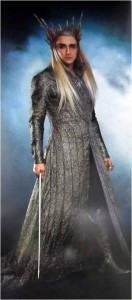 Anyone who’s read both The Silmarillion and The Hobbit will have noted the strong similarities between the Elvenking of Mirkwood and Thingol Greycloak. In this article, Tolkien scholar Michael Martinez examines whether, at the time Tolkien was writing The Hobbit, the Elvenking was intended to be Thingol himself.
Anyone who’s read both The Silmarillion and The Hobbit will have noted the strong similarities between the Elvenking of Mirkwood and Thingol Greycloak. In this article, Tolkien scholar Michael Martinez examines whether, at the time Tolkien was writing The Hobbit, the Elvenking was intended to be Thingol himself.
John Rateliff addressed this question in The History of The Hobbit without really closing the issue, although he favors the view (based on the available evidence) that the Elvenking of The Hobbit (whom we learn is named Thranduil in The Lord of the Rings) is NOT to be equated with King Thingol in The Silmarillion.
Rateliff’s research (which completes the work begun by his friend Taum Santoski, who sadly passed away before he could complete the work of documenting the history of The Hobbit) has revealed conclusively that when J.R.R. Tolkien was composing the original manuscripts of The Hobbit he clearly intended Bilbo Baggins to be a part of the same world as his great Silmarillion stories, but only in a peripheral sense. That is, Bilbo traveled AWAY from some (but not all) of the action in Beleriand.
There is one major inconvenience in the connections that Tolkien drew between Bilbo and Beleriand: he positioned the Necromancer to the south of Mirkwood, which if that character is indeed supposed to be the Thû of the 1930s “Silmarillion” (whom Tolkien transformed into Sauron for The Lord of the Rings), then the action in The Hobbit would have to take place somewhere in Dorthonion or northward — which is completely inconsistent with the geography of Beleriand that Tolkien had devised to that time.


